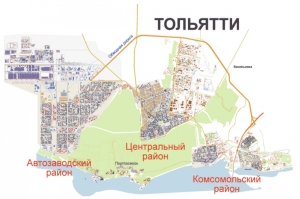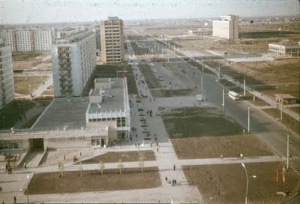The small town of Tol’iatti was meant to be the perfect socialist city; a booming industrial sector and a residential area that was built upon new architectural and modernization ideas. Tol’iatti had meant to be the tiny Volga city that showed monumental achievements in architecture that showed the “Soviet adaptation of international modernism” (17 Moments in History). The residents that had lived in Stravopol’ (was changed to Tol’iatti in the 1950s) were pushed from their homes and forced to make way for the newest and biggest thing, the Kuibyshev Hydroelectric Station. This dam was needed to expand the electricity generation in order to provide for the growing industrial sector called Avtograd or Auto Town.

Tol’iatti map depicting how the different sectors were organized and the basic structure.
Tol’iatti was split into three different sectors; Avtograd or the Auto Factory District, a residential area called Komsomolsky, and the “new city” called Central. These different sectors disconnected the community and with the establishment of the Avtograd had polluted the air, the ground and the water. However, Avtograd was a blank slate for Soviet planners and build the perfect “Socialist City” and they took over Tol’iatti with a fierceness. Most of the original residents had moved and left to other towns but they were replaced by the rush of auto workers and their families. These auto workers were recruited to construct the factory and had stayed in town with the prospects of getting a new apartment and a car. However, most of these autoworkers were very young and Tol’iatti’s residents were the youngest of any city in the USSR with the average age of 26.
With a lack of the indigenous residents and only the young residents of the town, Tol’iatti had been deprived “of an atmosphere of warmth and humanity”. Crime had started to pop up everywhere around the town. There were many cases of defacing public property, disturbing the peace and other crimes that made Tol’iatti the crime capital of the USSR. More crimes started happening when gang wars started popping up around the city that included stealing auto parts to stealing entire cars. These gangs had created turf wars to control the distribution of cars; they claimed many lives in the process.


Sources:
17 Moments in History (http://soviethistory.msu.edu/1968-2/toliatti/)
Images: http://soviethistory.msu.edu/1968-2/toliatti/toliatti-images/# and Wikipedia

The transformation of this city is a potential metaphor for the Soviet revolution more broadly, as the effort to build a whole new system was undermined by the inefficiencies of the system as well as the refusal of people to simply adhere to the plan. In the case of Tol’iatti, however, the deteriorating environmental conditions were especially harmful to the population.
LikeLike
Very interesting post. It’s crazy that the Soviets attempted to increase their industrial legitimacy so much that it ended up costing them the city itself. It is also interesting that with such a young crowd the government didn’t attempt to educate the youth or attempt to hire them in order to keep them off the streets and have them contribute to the city and the economy.
LikeLike